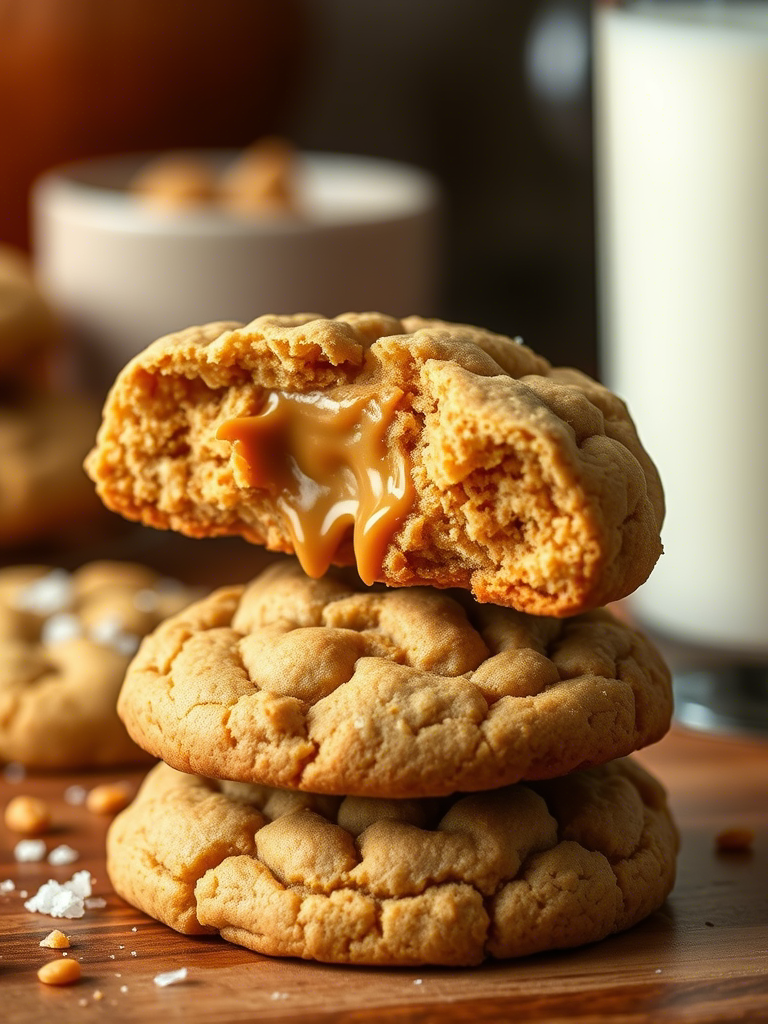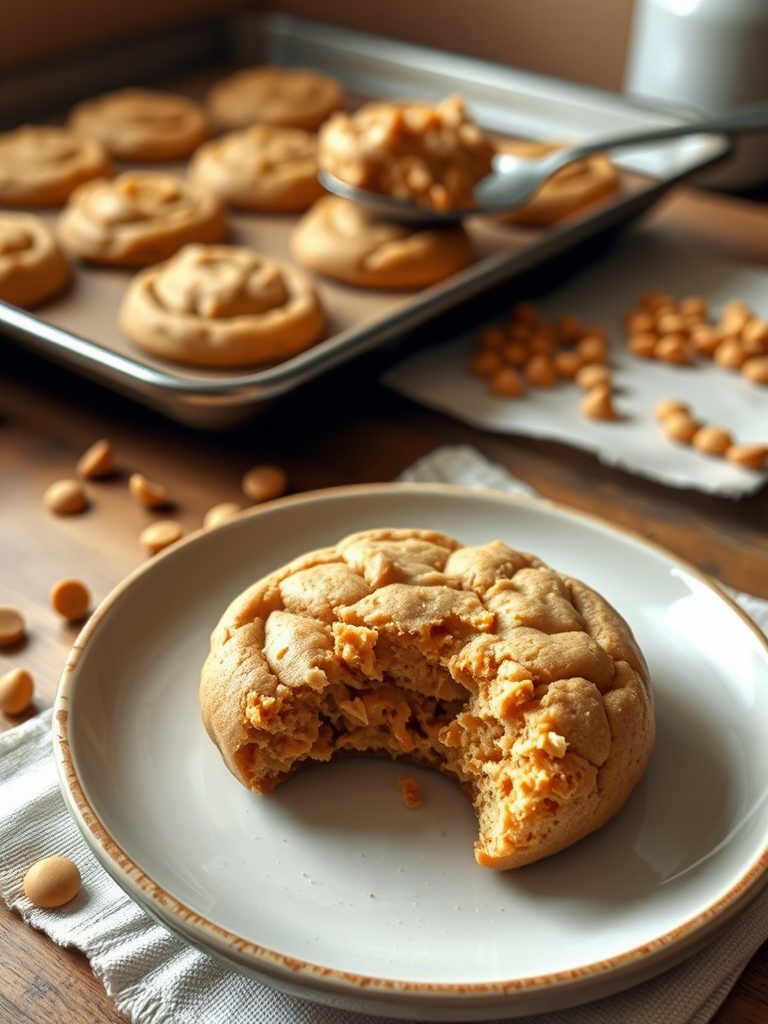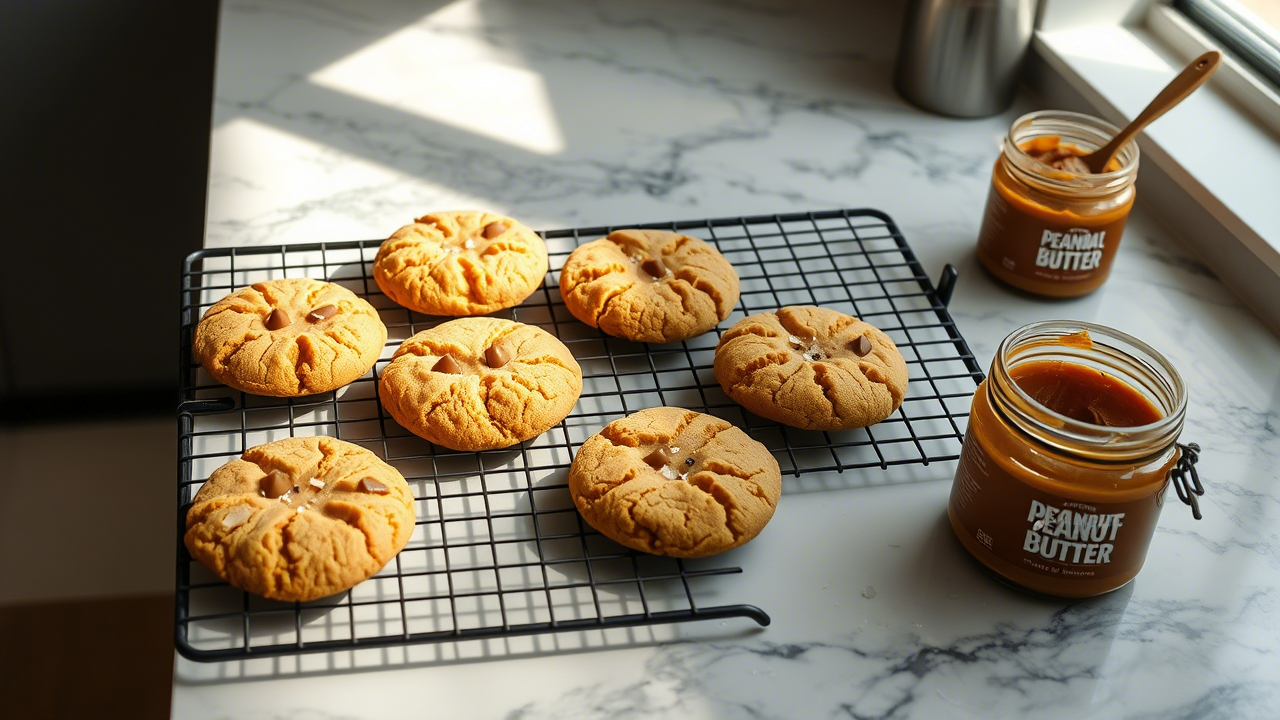You think you’ve had a peanut butter cookie. You haven’t. Not until you’ve sunk your teeth into a gourmet thick peanut butter cookie. Not the flat, dry, stick-to-the-roof-of-your-mouth kind. I mean the kind that makes pastry chefs smirk with pride. The kind that breaks in slow motion. Thick. Rich. Deeply nutty. Melt-in-your-mouth chewy with a hint of crisp at the very edge. That’s what we’re chasing here.
This isn’t your grandma’s recipe off the back of a peanut butter jar—though bless her heart, she meant well. This is the advanced course. For pros. For bakers who know flour types like sommeliers know grapes. We’re going deep. Ingredient science, texture mechanics, oven quirks. All of it. Let’s bake cookies that make people whisper in disbelief.
The Role of Peanut Butter: More Than Just Flavor
Let’s start with the obvious player—peanut butter. But not just any peanut butter.
Most home bakers grab the classic creamy stuff. Big-brand, shelf-stable, sweetened. But gourmet baking asks more. Choose a natural-style peanut butter with 90-100% peanuts. Salted or unsalted? Honestly, that’s your call—just adjust the recipe salt to match.
Natural peanut butter brings two things: complexity and oil content. The oil matters. It affects spread and chew. Too much, and your cookie puddles like a pancake. Too little, and it crumbles like a dry scone.
Some pros even blend two types—50% commercial (like Jif) and 50% natural. Why? Structure from the stabilizers, flavor from the roasted peanut oil. Smart baking is strategic baking.
Oh, and chunky vs. creamy? That’s texture philosophy. Chunky adds tooth. Creamy flows better in dough. But don’t just pick what you like—pick what fits your vision.
Fat and Sugar: Why Ratios Are Everything
Here’s where we separate the good from the god-tier.
In gourmet peanut butter cookies, fat balance is key. You already get some from the peanut butter—so how much butter do you really need? Standard recipes overdo it. For a thick cookie that holds height and boasts a tender middle, you want just enough butter to soften but not so much that it melts the dough.
Experts often use an 80:20 split of peanut butter to butter (by weight). That ratio respects the peanut’s natural fat and still gives buttery depth. Too much butter = flat city. Not today.
As for sugar, we’re looking at a brown-to-white sugar ratio that leans brown. Light brown sugar brings moisture. Dark brown brings chew and a slightly deeper molasses tone. A 2:1 brown to white ratio gives you that toffee-adjacent vibe, especially when paired with roasted peanut butter.
One study published in the Journal of Food Science (Vol. 78, Issue 12) found that brown sugar contributes significantly to Maillard browning at lower baking temps, producing richer flavor and aroma. In simpler words—it makes your cookie smell and taste like magic.
Don’t skip the science. It’s not just sweet—it’s structure.

Flour Choices: Why AP Isn’t Always Enough
All-purpose flour is fine. Good, even. But for gourmet thick peanut butter cookies? Let’s push a bit further.
You want height and chew. Too much AP flour can make things pasty or doughy. Smart bakers use a blend—usually 75% all-purpose and 25% bread flour.
Bread flour has more protein. That gives the cookie structure and elasticity. When combined with peanut butter (a natural tenderizer), this blend keeps the cookie thick without becoming cakey. It holds the lift without drying out. It’s like scaffolding in a skyscraper.
Some pastry chefs even experiment with oat flour—5 to 10% max—for added nuttiness and texture. But don’t go rogue unless you’ve tested it. Cookies are chemistry. Respect the ratios.
Eggs, Yolk, and the Secret of Emulsification
Eggs do a lot more than bind. They lift, emulsify fats, retain moisture, and add structure.
But here’s where gourmet cookie bakers level up—they separate and control the yolk-to-white ratio. Want denser cookies? Use one whole egg plus one yolk. The extra fat from the yolk makes a more tender interior.
Some chefs go even further. They use room temp eggs only. Cold eggs won’t emulsify properly with butter and sugar, and that weakens the dough’s final structure. You want everything room temp unless stated otherwise. It’s a small thing with big consequences.
Ever heard of a cookie that crumbles mid-lift off the baking sheet? That’s poor emulsification. Egg work matters. No shortcuts.
Chill Time and Dough Resting: The 24-Hour Gospel
Here’s where pros earn their crust.
Let your dough rest. No, seriously—rest it. At least 12 hours. Ideally 24.
Why? A study by Harold McGee in On Food and Cooking explains that resting dough allows flour to fully hydrate, fat to re-solidify, and flavors to deepen. Gluten relaxes. Sugars absorb. The dough becomes complex.
You’ll also notice something else: chilled dough bakes taller. The cold fat melts slower, giving the cookie a head start on setting before it spreads. That means a thicker, chewier result.
Scoop before chilling. Not after. Dough’s like cement once cold. Use a 2 oz cookie scoop or weigh them at 60g each for uniformity.
This step separates homey from heavenly.
Baking Technique: Not All Heat Is Equal
Every oven lies. That’s rule one.
Always use an oven thermometer. Your dial may say 350°F, but your cookies could be roasting at 375. That means overbrowning or raw centers.
For gourmet thick peanut butter cookies, aim for 325°F to 340°F max. Slow and steady. Higher temp = more spread. Lower temp = taller, even bake.
Bake on parchment. Not silicone. Silicone mats retain heat too well and flatten your base.
Also, double pan if possible—one baking sheet stacked on another. It softens bottom heat, preventing burnt bottoms before the top finishes.
Pull them just before you think they’re ready. If they look set in the middle, they’re overbaked. Residual heat finishes the job. You want that molten middle when you first crack it open.
Oh, and never bake with warm dough. That’s sabotage.

Finishing Touches: Elevation Is In The Details
A great cookie is made in the oven. A gourmet cookie is made after it.
The second those cookies come out, you hit them with flaky salt. Maldon, smoked sea salt, something dramatic. That contrast wakes up the peanut flavor.
Optional, but delicious: press a few chopped roasted peanuts or crushed pretzels into the tops just before baking. It adds visual interest, crunch, and nuance.
For a dessert-forward approach, sandwich two cookies with a smear of dark chocolate ganache or caramelized banana buttercream. That’s Michelin star territory.
Even plating matters. Serve slightly warm, on a chilled plate, with a spoon of peanut butter whipped cream on the side. Not because it needs it—because it deserves it.
Emerging Trends: What Pros Are Experimenting With
Top pastry chefs are always innovating. Right now, trends include:
- Tahini Swaps: Using partial tahini instead of peanut butter for a nutty twist. Earthier, creamier, slightly bitter.
- Sourdough Discard: A tablespoon or two adds tang and improves chew. Wild but effective.
- Brown Butter: Replace part of the butter with browned butter for toasty complexity. Be careful—it lowers spread resistance.
- Dehydrated Peanut Dust: Dusting baked cookies with powdered roasted peanut skin for that artisan “wow.”
And the wildest? Savory PB cookies with miso, chili flakes, or even parmesan. They’re not dessert. They’re a statement.
Common Mistakes to Avoid
Let’s clean up some rookie errors:
- Overbaking: They firm up as they cool. Trust the soft center.
- Not measuring by weight: Cups lie. Use a scale.
- Wrong peanut butter: Natural = flavor. Commercial = texture. Use wisely.
- Skipping the rest: If you’re baking immediately, just don’t. Go buy a granola bar.
Final Thoughts: The Cookie Worth Mastering
Gourmet thick peanut butter cookies aren’t just dessert—they’re craft. They require patience, precision, and a little bit of nerve. You’ll mess one up. Maybe five. But when you get it right, the reward is borderline emotional.
They’re rustic but refined. Familiar, yet elevated. And when served warm, with the slightest give in the center, they’ll silence even the most talkative table.
Try different peanut butters. Play with salt. Swap sugars. Let your palate lead. The thick cookie is a blank canvas—one that smells like toasted peanuts and victory.
Now go bake. Just don’t forget the salt on top. That’s the part that makes people say, “Oh wow… wait, what is this?”
FAQs
What makes these peanut butter cookies “gourmet”?
Premium ingredients, precise ratios, dough resting, and advanced baking techniques elevate them beyond basic recipes.
Why does the dough need to chill for 24 hours?
Chilling develops flavor, improves structure, and prevents cookies from overspreading during baking.
Can I use crunchy peanut butter instead of creamy?
Yes, but it’ll change the texture—chunky gives more bite, while creamy keeps it smooth and uniform.
What type of peanut butter works best?
A mix of natural and commercial peanut butter gives the ideal combo of flavor and structure.
How do I make the cookies thicker?
Use a higher peanut butter-to-butter ratio, bread flour, and chill the dough thoroughly.
Can I substitute the flour?
Partially—replace a small portion with oat or bread flour, but keep the majority all-purpose for balance.
Why do I need both brown and white sugar?
Brown sugar adds moisture and chewiness, while white sugar helps with spread and crispness.
Should I use salted or unsalted peanut butter?
Either works—just adjust the added salt in the recipe accordingly.
What’s the benefit of adding an extra egg yolk?
It boosts richness and tenderness without making the cookie cakey.
Can I bake the dough immediately?
Technically yes, but the flavor and texture won’t reach their full potential without chilling.
Why do you recommend using two baking sheets?
Double panning prevents the bottoms from overbaking and promotes even heat distribution.
Do I really need a kitchen scale?
Yes—accurate weights mean consistent, professional-level results every time.
How do I know when the cookies are done?
They should look slightly underbaked in the center—carryover heat finishes them as they cool.
Is it okay to use brown butter?
Yes, but it lowers the dough’s melting point, so expect more spread unless you chill it longer.
What’s the best way to finish the cookies?
Top with flaky sea salt and maybe crushed peanuts or pretzels for extra flavor and texture.
Ask ChatGPT

Mariana is a passionate home cook who creates delicious, easy-to-follow recipes for busy people. From energizing breakfasts to satisfying dinners and indulgent desserts, her dishes are designed to fuel both your body and hustle.
When she’s not in the kitchen, she’s exploring new flavors and dreaming up her next recipe to share with the Foodie Hustle community.

